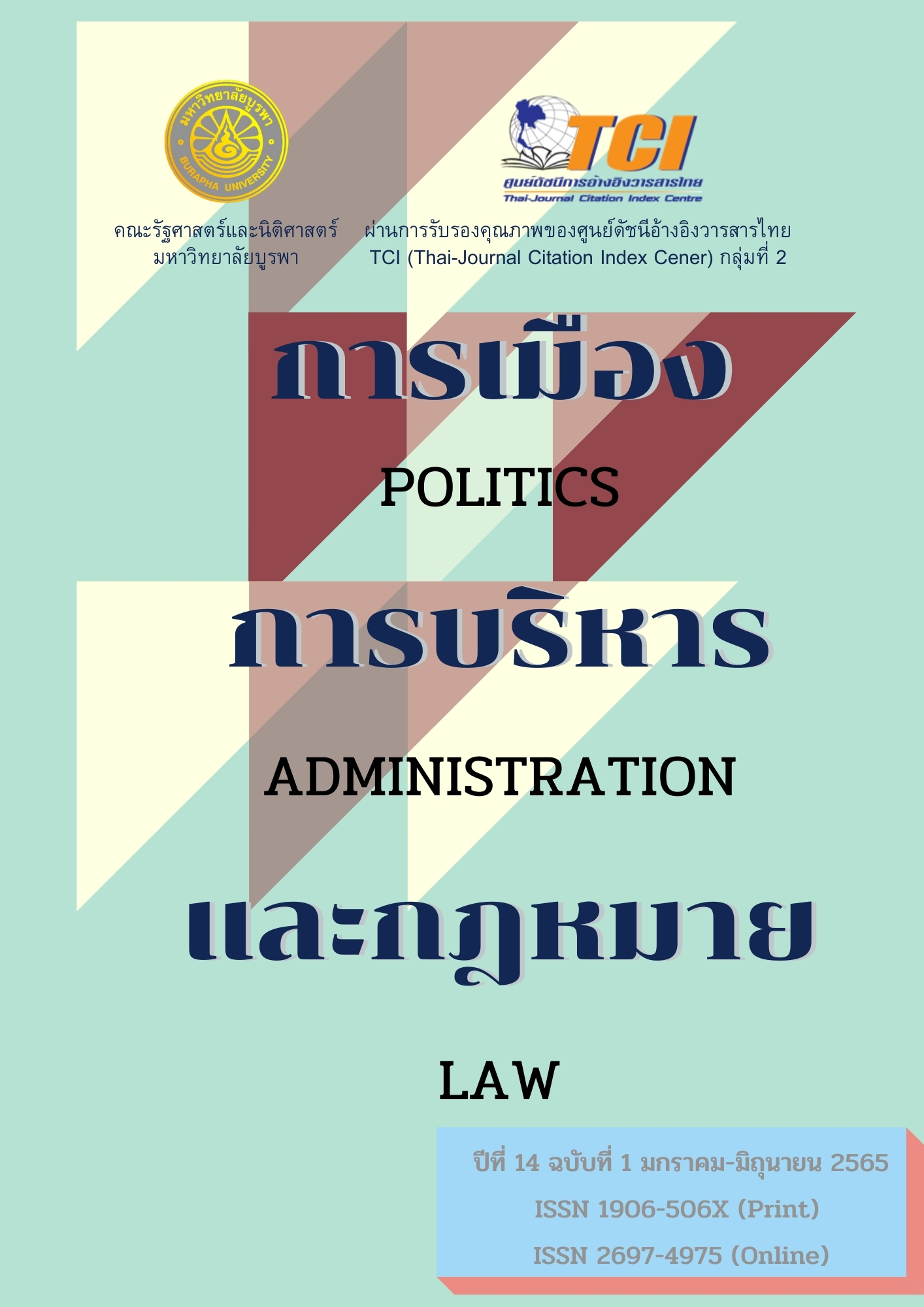ความผูกพันในการเรียนออนไลน์ของนักศึกษา: กรณีศึกษามหาวิทยาลัยรามคำแหง
คำสำคัญ:
ความผูกพันในการเรียน, การเรียนออนไลน์, การเรียนออนไลน์ในมหาวิทยาลัยบทคัดย่อ
การวิจัยนี้เป็นการวิจัยเชิงปริมาณมีวัตถุประสงค์เพื่อศึกษาความผูกพันในการเรียนออนไลน์ (Engagement in Online Learning) และใช้ค่าสัมประสิทธ์ทดถอยพหุในการวัดค่าตัวแปรสำคัญที่มีผลต่อความผูกพันในการเรียนทางออนไลน์ของนักศึกษา ใช้แบบสอบถามเป็นเครื่องมือในการเก็บข้อมูลจากนักศึกษามหาวิทยาลัยรามคำแหงที่เรียนทางออนไลน์ในช่วงเดือนกรกฎาคมถึงเดือนกันยายน 2564 ผลการศึกษามีดังต่อไปนี้ นักศึกษาที่เรียนทางออนไลน์มีอายุโดยฉลี่ย 29 ปี ส่วนใหญ่เป็นนักศึกษาชาย คิดเป็นร้อยละ 64.1 นักศึกษาทำงานหารายได้ควบคู่ไปกับการเรียนคิดเป็นร้อยละ 73.5 งานที่ทำส่วนใหญ่เป็นพนักงานบริษัทหรือลูกจ้างร้านค้า มีรายได้โดยเฉลี่ย 13,000 บาทต่อเดือน การเรียนทางออนไลน์ของนักศึกษามากกว่าครึ่ง (ร้อยละ 56.7) ใช้โทรศัพท์มือถือในการออนไลน์เข้าเรียน การศึกษาระดับความผูกพัน (Engagement)ในการเรียนออนไลน์ของนักศึกษาพบว่า ความผูกพันในการเรียนออนไลน์มีระดับปานกลาง กล่าวคือ นักศึกษามีการอ่านและติดตามทุกข้อความที่อาจารย์เขียนหรือโพสทางออนไลน์ ติดตามข้อมูลข่าวสารการสอนทางออนไลน์ทุกวิชา มีความพอใจในการเข้าร่วมกิจกรรมต่างๆ ในการเรียนการสอนทางออนไลน์ มีการออนไลน์เข้าร่วมชั้นเรียนตั้งแต่ต้นจนจบการบรรยาย ทำการบ้านและงานอื่นๆ ที่ได้รับจากการเรียน และเข้าเรียนทางออนไลน์ครบทุกครั้งในทุกวิชาที่มีการลงทะเบียนเรียน ผลวิจัยพบว่า ตัวแปรความตั้งใจจริงในการเรียนออนไลน์ การเข้าถึงในการเรียนออนไลน์ การสอนของอาจารย์ผู้สอน และสัมพันธภาพของนักศึกษากับอาจารย์ เป็นตัวแปรสำคัญที่มีผลต่อการเรียนออนไลน์อย่างมีนัยสำคัญทางสถิติ โดยมีความสัมพันธ์ไปทางเดียวกันกับความผูกพันในการเรียนออนไลน์และสามารถอธิบายการเปลี่ยนแปลงความผูกพันในการเรียนออนไลน์ได้ร้อยละ 45 นอกนั้นสามารถอธิบายได้ด้วยตัวแปรอื่นที่ไม่ได้นำมาศึกษา ในการเปรียบเทียบผลของตัวแปรที่มีต่อความผูกพันในการเรียนออนไลน์พบว่า การเข้าถึงในการเรียนออนไลน์มีผลต่อความผูกพันในการเรียนออนไลน์มากที่สุด รองลงมาคือ การสอนของอาจารย์ผู้สอนทางออนไลน์ สัมพันธภาพของนักศึกษากับอาจารย์ และความตั้งใจจริงในการเรียนออนไลน์ของนักศึกษาตามลำดับ
เอกสารอ้างอิง
มหาวิทยาลัยเทคโนโลยีพระจอมเกล้าธนบุรี (KMUTT). (ม.ป.ป). วันที่ค้นข้อมูล 23 เมษายน 2563, เข้าถึงได้ จาก http://www.kmutt.ac.th/organization/Education/Technology/tech_ed/constructionism/ constructionism2. html
สุรศักดิ์ วานิชชัยวัฒกุล. (ม.ป.ป.) ทฤษฎีการเรียนรู้. วันที่ค้นข้อมูล 23 เมษายน 2563, เข้าถึงได้จาก http://www. novabizz.com/NovaAce/Learning.htm
Akyol, Z., Vaughan, N., & Garrison, D. R. (2011). The impact of course duration on the Development of a community of inquiry. Interactive Learning Environments, 19(3), 231-246.
Cai, Q. (2017). Enhance student engagement through leadership strategies. Transformative Dialogues: Teaching & Learning Journal, 9(3), 1-7.
Cochran, W. G. (1953). Sampling Techniques. Retrieved January 5, 2021, from http://www.personalityresearch.org/papers/ clark.html
Cohen, J. (1988). Statistical Power Analysis for the Behavior Sciences (2nd ed.). Lawrence Erlbaum Associates, United State of America.
Cronbach, L. J. (1970). Essentials of Psychological Test (5th ed.). New York: Harper Collins.
Dennis. (2021). 10 Proven Ways to Increase Audience Engagement on Your eCommerce. Retrieved May 1, 2020, from https://en.wikipedia.org/wiki/Seymour_Papert
Deschaine, M. E., & Whale, D. E. (2017). Increasing student engagement in online educational leadership courses. Journal of Educators Online, 14(1), 36-47.
Dixson, M. D. (2010). Creating effective student engagement in online courses: What do students find engaging?. Journal of the Scholarship of Teaching and Learning, 10(2), 1-13.
Dixson, M. D. (2015). Measuring student engagement in the online course: The online student engagement scale (OSE). Online Learning, 19(4), 143-157.
Gray, J. A., & DiLoreto, M. (2016). The effects of student engagement, student satisfaction, and perceived learning in online learning environments. International Journal of Educational Leadership Preparation, 11(1), n1.
Garrison, D. R., Anderson, T., & Archer, W. (2001). Critical thinking, cognitive presence, and computer conferencing in distance education. American Journal of Distance Education, 15(1), 7-23.
Martin, F., & Bolliger, D. U. (2018). Engagement matters: Student perceptions on the importance of engagement strategies in the online learning environment. Online Learning, 22(1), 205-222.
Meyer, K. A. (2014). Student engagement in online learning: What works and why. ASHE Higher Education Report, 40(6), 1-14.
Papert, S. (1928). Wikipedia Seymour Papert. Retrieved April 22, 2020 from https://en.wikipedia.org/wiki/Seymour_Papert
Raitaluoto, T. (2022). How to increase your website engagement [Ultimate guide]. Retrieved April 1,2020 from https://www.coredna.com/blogs/increase-website-engagement.
Stephan, S. H. (2017). Embracing engagement through technology in online legal education. Distance Learning, 14(3), 37-41.
Swan, K., Shea, P., Richardson, J., Ice, P., Garrison, D. R., Cleveland-Innes, M., & Arbaugh, J. B. (2008). Validating a measurement tool of presence in online communities of inquiry. E-mentor, 2(24), 1-12.
Vayre, E., & Vonthron, A. M. (2017). Psychological engagement of students in distance and online learning: Effects of self-efficacy and psychosocial processes. Journal of Educational Computing Research, 55(2), 197-218.
Yamane, T. (1967). Taro Statistic: An Introductory Analysis. New York: Harper & Row.
Young, S., & Bruce, M. A. (2011). Classroom community and student engagement in online courses. Journal of Online Learning and Teaching, 7(2), 219-230.
ดาวน์โหลด
เผยแพร่แล้ว
ฉบับ
ประเภทบทความ
สัญญาอนุญาต

อนุญาตภายใต้เงื่อนไข Creative Commons Attribution-NonCommercial-NoDerivatives 4.0 International License.






